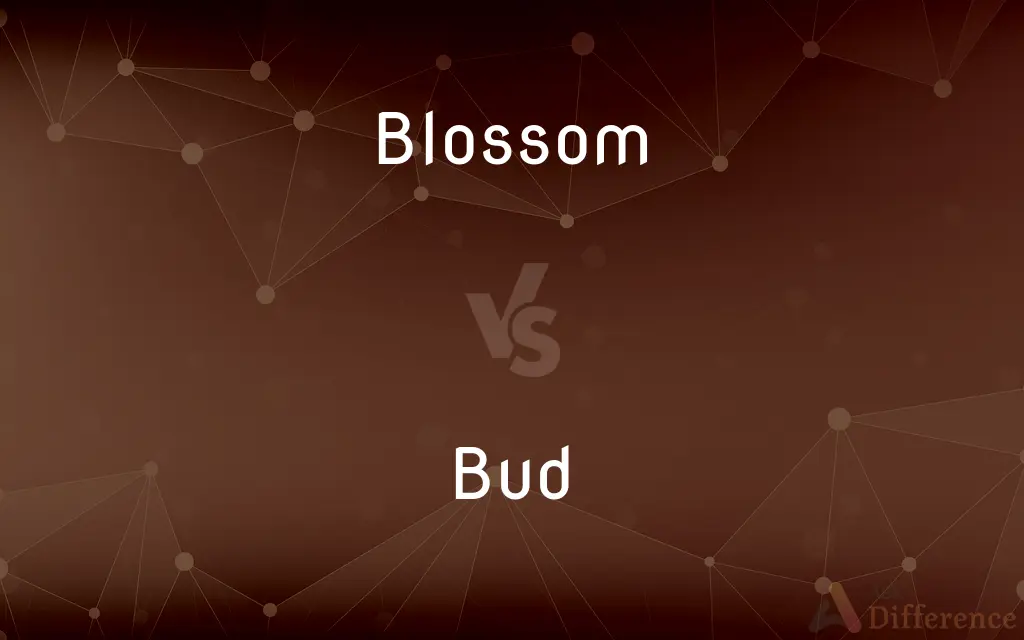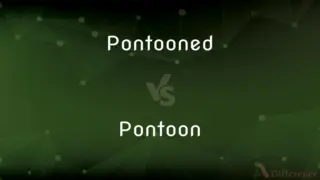Blossom vs. Bud — What's the Difference?
By Urooj Arif & Fiza Rafique — Updated on March 29, 2024
A blossom is a flower or group of flowers, representing the flowering stage in plants while a bud is a compact undeveloped shoot, leaf, or flower, showing potential for growth.

Difference Between Blossom and Bud
Table of Contents
ADVERTISEMENT
Key Differences
Blossoms are the mature state of a bud, specifically referring to flowers or clusters of flowers. They signify the reproductive phase in many plants, attracting pollinators with their colors, shapes, and scents. Buds are the early stage in a plant's development, representing potential for future growth. These are compact and often enclosed by protective scales or leaves, preparing to develop into new shoots, leaves, or flowers.
While buds are characterized by their compact size and protective function, blossoms are noted for their aesthetic and biological roles in the plant's life cycle. Buds are preparatory, containing the undeveloped promise of new plant parts, whereas blossoms are the fulfillment of this promise, especially in the context of reproduction. Blossoms may consist of petals, stamens, and pistils, which are not visible in the bud stage.
The transition from bud to blossom is a critical phase in the plant's life, marking a shift from growth to reproduction. This process involves significant changes at the cellular level, with the bud developing into a flower that can produce seeds for the next generation. While all blossoms originate from buds, not all buds result in flowers; some may develop into leaves or stems.
Buds are essential for the plant's survival and propagation, acting as a mechanism for continued growth and adaptation. Blossoms, while also serving a reproductive function, add beauty to the environment and play a crucial role in ecosystems, providing food and attracting pollinators. The presence of blossoms often indicates the health and vitality of a plant, as well as the onset of the reproductive season.
In terms of gardening and horticulture, the care for buds involves ensuring the right conditions for growth, such as proper light, water, and nutrients. Care for blossoms may focus more on maximizing the display of flowers, including practices like deadheading to encourage more blooms. Both stages are integral to the life cycle of plants, with each serving distinct but interrelated purposes in the plant's development and reproduction.
ADVERTISEMENT
Comparison Chart
Definition
A flower or group of flowers; the flowering stage of a plant
An undeveloped or early stage of a plant part, especially a shoot, leaf, or flower
Function
Reproduction and attraction of pollinators
Potential for growth into new plant parts
Visible Characteristics
Features petals, stamens, and pistils
Compact, often enclosed by scales or leaves
Stage in Life Cycle
Reproductive stage
Early growth stage
Role in Gardening
Often the focus of care for display and pollination
Monitored for plant health and growth potential
Compare with Definitions
Blossom
Represents the plant's reproductive stage.
Bees were attracted to the vibrant blossoms, pollinating the garden.
Bud
Enclosed by protective layers, a bud holds undeveloped plant parts.
Each spring, the buds on the trees hint at the lush foliage to come.
Blossom
The flower of a plant, especially when open.
The cherry blossoms created a stunning pink canopy overhead.
Bud
A plant's early growth stage, indicating future leaves or flowers.
The rose bush was full of small, green buds waiting to open.
Blossom
Indicates health and vitality in plants.
A tree full of blossoms is a sign of a well-nourished and healthy plant.
Bud
The potential for vegetative or floral growth.
Gardening enthusiasts eagerly watch for buds as signs of healthy plant development.
Blossom
Consists of petals, stamens, and pistils.
The blossom's bright petals opened to reveal its delicate stamens.
Bud
Can develop into leaves, flowers, or shoots.
The apple tree's buds burst into both new leaves and blossoms.
Blossom
Attracts pollinators, playing a key role in ecosystems.
The garden's blossoms attracted a variety of bees and butterflies.
Bud
Critical for the plant's continued growth and reproduction.
Ensuring buds survive the winter is key for spring growth.
Blossom
In botany, blossoms are the flowers of stone fruit trees (genus Prunus) and of some other plants with a similar appearance that flower profusely for a period of time in spring. Colloquially, flowers of orange are referred to as such as well.
Bud
In botany, a bud is an undeveloped or embryonic shoot and normally occurs in the axil of a leaf or at the tip of a stem. Once formed, a bud may remain for some time in a dormant condition, or it may form a shoot immediately.
Blossom
A flower or a mass of flowers, especially on a tree or bush
Tiny white blossoms
The slopes were ablaze with almond blossom
Bud
A small protuberance on a stem or branch, sometimes enclosed in protective scales and containing an undeveloped leaf, flower, or leafy shoot.
Blossom
(of a tree or bush) produce flowers or masses of flowers
A garden in which roses blossom
Bud
The stage or condition of having buds
Branches in full bud.
Blossom
A flower or cluster of flowers.
Bud
Flowers from a female cannabis plant, especially after being harvested and prepared for smoking or other use
Bought some bud.
Blossom
The condition or time of flowering
Peach trees in blossom.
Bud
A single flower of a cannabis plant, especially a female flower
When to harvest buds.
Blossom
A condition or period of maximum development. ]
Bud
A small, rounded organic part, such as a taste bud, that resembles a plant bud.
Blossom
A flower, especially one indicating that a fruit tree is fruiting; (collectively) a mass of such flowers.
The blossom has come early this year.
Bud
One that is not yet fully developed
The bud of a new idea.
Blossom
The state or season of producing such flowers.
The orchard is in blossom.
Bud
An earbud.
Blossom
(figurative) A blooming period or stage of development; something lovely that gives rich promise.
Bud
Friend; chum. Used as a form of familiar address, especially for a man or boy
Move along, bud.
Blossom
The colour of a horse that has white hairs intermixed with sorrel and bay hairs.
Bud
To put forth or produce buds
A plant that buds in early spring.
Blossom
(intransitive) To have, or open into, blossoms; to bloom.
Bud
To develop or grow from or as if from a bud
"listened sympathetically for a moment, a bemused smile budding forth" (Washington Post).
Blossom
(intransitive) To begin to thrive or flourish.
Bud
To cause to put forth buds.
Blossom
The flower of a plant, or the essential organs of reproduction, with their appendages; florescence; bloom; the flowers of a plant, collectively; as, the blossoms and fruit of a tree; an apple tree in blossom.
Blossoms flaunting in the eye of day.
Bud
To graft a bud onto (a plant).
Blossom
A blooming period or stage of development; something lovely that gives rich promise.
In the blossom of my youth.
Bud
A newly sprouted leaf or blossom that has not yet unfolded.
After a long, cold winter, the trees finally began to produce buds.
Blossom
The color of a horse that has white hairs intermixed with sorrel and bay hairs; - otherwise called peach color.
Bud
A small rounded body in the process of splitting from an organism, which may grow into a genetically identical new organism.
In this slide, you can see a yeast cell forming buds.
Blossom
To put forth blossoms or flowers; to bloom; to blow; to flower.
The moving whisper of huge trees that branchedAnd blossomed.
Bud
Potent cannabis taken from the flowering part of the plant (the "bud"), or marijuana generally.
Hey bro, want to smoke some bud?
Blossom
To flourish and prosper; to develop into a superior type.
Israel shall blossom and bud, and full the face of the world with fruit.
Bud
A weaned calf in its first year, so called because the horns are then beginning to bud.
Blossom
To appear or grow as if by blossoming; to spread out rapidly.
Bud
A pretty young girl.
Blossom
Reproductive organ of angiosperm plants especially one having showy or colorful parts
Bud
Buddy, friend.
I like to hang out with my buds on Saturday night.
Blossom
The period of greatest prosperity or productivity
Bud
Used to address a male
Blossom
Produce or yield flowers;
The cherry tree bloomed
Bud
(intransitive) To form buds.
The trees are finally starting to bud.
Blossom
Develop or come to a promising stage;
Youth blossomed into maturity
Bud
(intransitive) To reproduce by splitting off buds.
Yeast reproduces by budding.
Bud
(intransitive) To begin to grow, or to issue from a stock in the manner of a bud, as a horn.
Bud
(intransitive) To be like a bud in respect to youth and freshness, or growth and promise.
Bud
(transitive) To put forth as a bud.
Bud
(transitive) To graft by inserting a bud under the bark of another tree.
Bud
A small protuberance on the stem or branches of a plant, containing the rudiments of future leaves, flowers, or stems; an undeveloped branch or flower.
Bud
A small protuberance on certain low forms of animals and vegetables which develops into a new organism, either free or attached. See Hydra.
Bud
To put forth or produce buds, as a plant; to grow, as a bud does, into a flower or shoot.
Bud
To begin to grow, or to issue from a stock in the manner of a bud, as a horn.
Bud
To be like a bud in respect to youth and freshness, or growth and promise; as, a budding virgin.
Bud
To graft, as a plant with another or into another, by inserting a bud from the one into an opening in the bark of the other, in order to raise, upon the budded stock, fruit different from that which it would naturally bear.
The apricot and the nectarine may be, and usually are, budded upon the peach; the plum and the peach are budded on each other.
Bud
A partially opened flower
Bud
A swelling on a plant stem consisting of overlapping immature leaves or petals
Bud
Develop buds;
The hibiscus is budding!
Bud
Start to grow or develop;
A budding friendship
Common Curiosities
What is the main difference between a bud and a blossom?
A bud is the early, undeveloped stage of a plant part, while a blossom is a mature flower.
What signals the transition from bud to blossom?
The transition is marked by the bud opening up to reveal the flower, a process influenced by genetic and environmental factors.
Why are blossoms important to plants?
Blossoms are crucial for reproduction, attracting pollinators to help with the transfer of pollen.
Can environmental factors affect the budding process?
Yes, factors like temperature, light, and water availability can significantly impact bud development.
How do you care for plant buds?
Care involves providing optimal growing conditions, including adequate water, light, and nutrients.
How do buds protect future plant parts?
Buds are often encased in scales or protective coverings that shield the delicate parts inside from harsh weather and predators.
Can all buds become blossoms?
Not all buds become blossoms; some develop into leaves or shoots instead.
Are there any plants without blossoms?
Yes, some plants, like ferns and mosses, reproduce without blossoms, using spores instead.
What attracts pollinators to blossoms?
Pollinators are attracted by the blossom's colors, scents, and sometimes nectar.
Why might a plant fail to produce blossoms?
Lack of blossoms can be due to insufficient light, nutrients, water, or incorrect pruning practices.
Share Your Discovery

Previous Comparison
Pontooned vs. Pontoon
Next Comparison
Elite vs. ElectAuthor Spotlight
Written by
Urooj ArifUrooj is a skilled content writer at Ask Difference, known for her exceptional ability to simplify complex topics into engaging and informative content. With a passion for research and a flair for clear, concise writing, she consistently delivers articles that resonate with our diverse audience.
Co-written by
Fiza RafiqueFiza Rafique is a skilled content writer at AskDifference.com, where she meticulously refines and enhances written pieces. Drawing from her vast editorial expertise, Fiza ensures clarity, accuracy, and precision in every article. Passionate about language, she continually seeks to elevate the quality of content for readers worldwide.















































